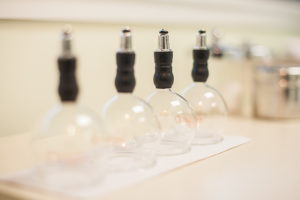To understand what cupping is and why we are seeing it on our Olympic athletes, we first have to understand a basic principle of Chinese Medicine. The concept is based on the notion of qi (energy) and blood moving smoothly through our meridian system (channels through the body) nourishing our muscles, sinews, fascia, nerves etc. If there is a disruption in this flow, which can be caused by an injury or by overuse, then there is pain. There is a saying, “Bu tong ze tong, tong ze bu tong” which translates to “Free flow, no pain; no free flow, pain”. It is the role of the acupuncture practitioner to restore free flow by stimulating acupuncture points on the affected channel of the area of pain and by using other methods such as Gua Sha (a scraping technique) and yes, CUPPING to relieve pain.

Cupping has been used as a treatment modality for thousands of years, with the first written evidence of its use in the 1st century BCE. Back then and even in modern times the term used to describe this therapy was “fire cups”. Sounds exciting doesn’t it! This method has the practitioner insert a flame into a specialized glass cup (not the kind you drink out of) to withdraw all of the oxygen and then place the cup on the affected area, creating a vacuum and drawing the flesh up into the cup. PLEASE DO NOT TRY THIS AT HOME! This technique requires practice and the training of a professional otherwise burns or other calamities could arise (think dropping flame source on the floor). Many professionals still use this technique to create the suction for the cup, however thanks to modern innovations there are easier cups to use. These include suction cups, which have a pump which removes the air and allows for greater control on the amount of vacuum created. Silicone cups, another option, are soft and pliable and can be used on bonier areas or on children.
Olympic record breaker, Michael Phelps, brought cupping into the national spotlight when he emerged in the swimming arena with purple circles on his back and upper arms. Perhaps cupping helped propel him to break a 2000 year old record, which is also around the time the first documented use of cupping. Could it be possible the ancient Greek Leonidas used cupping to propel him to win gold medals in his shield carrying races? We may never know; but the idea of “drawing things out” of an individual were prevalent in ancient medicines. In those days, it was common practice to use leeches and other means to accomplish this. Thankfully, we have evolved our techniques.
In Chinese Medicine, cupping can have a variety of uses. In the case of Phelps and other athletes its use would be to move qi and blood in an area to decrease pain and increase mobility of the musculature. Cupping can also be used on patients who are coming down with or are recovering from illness in the respiratory system, with cups placed over the back to move the qi in the chest.
The cupping marks on Phelps were quite purple and that could indicate that the stagnation is of chronic nature. The marks are due to the rupture of surface capillaries. A patient who has had cupping may have marks that are pale and fade quickly or are darker and longer lasting. The suction also works with the lymph fluid, increasing blood flow to the area and stimulating an immune response on the cellular level.
Cupping is a wonderful adjunct therapy to acupuncture, but it is not for everybody. There are contraindications as to who can receive cupping, as well as certain areas of the body which are not cupped at all. The amount of suction and the length of time the cups are left in place depends on the overall health of the individual.
I read a story this week, that one of the Olympic trainers had an athlete place a cup on his forehead (a body part not typically cupped) because he had a headache. While the suction cups are wildly available, it is important to see a licensed professional for best results. If you suffer from headaches, chronic pain in your back, legs, or hips or are have a lingering cough from a recent illness then talk to your acupuncturist to see if cupping might help you to feel your best!
